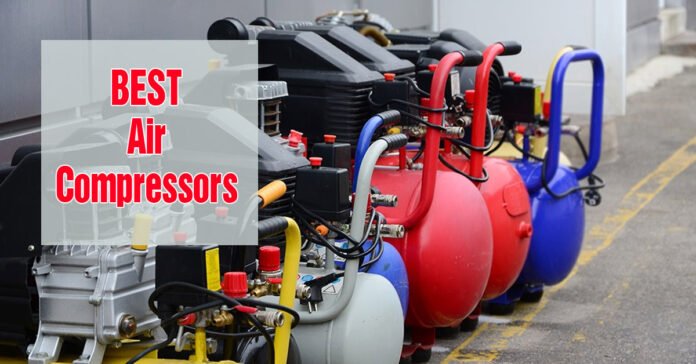Air Compressor Buying Guide
Depending on the job, your budget and the brand; finding the best air compressor can be a bit of a to-do. Knowing the right product for your project can also change the cost. Air compressors generally run in one of two ways, electric or gasoline and both provide something a little different. There are pros and cons for each and you’ll want to consider them before purchasing. Another handy tip is to decide whether or not this tool is really for you. If you spend a lot of time working within the garage, building, painting or landscaping, you’ll definitely benefit from them.
Air compressors measure power in both CFM (cubic feet per minute) and HP (horsepower). Make sure to take note of the gallon size as well; because this will let you know how much air is in reserve.
Gasoline Air Compressor- Pros and Cons
This style of the compressor is great for those that work in more rural areas; they might struggle with reliable electricity. Having enough open air and room between you and your neighbor is important though; as gas-powered compressors are not only smelly but very loud. You’ll want to have a proper ventilation system if you plan on working in confined spaces; maybe some ear protectors as well. The nice thing about this kind of compressor as that if the power does go out. Luckily, you’ll still be able to use it!
Electric Pros and Cons
Electric compressors are the more popular option as they don’t smell. This style of the tool can be for indoors while the power gas one can not. If you’re planning to do some in home renovations, this just might be the option for you. However, they can be very difficult to move around. So, if you’re planning on getting both indoor and outdoor work with a compressor; it is good to have one of each. You’ll also need to live in an area where you can ensure a constant flow of electricity. In order to avoid lapses in work.
Another thing to keep in mind is how often and for how long you intend to use the machine. Certain kinds can’t handle big projects unless you get a much bigger and louder compressor. Tank size, CFM and where your work will be taking place are the three main components to finding the best compressor for your task. Even after you’ve spotted the one you like; reading up reviews and going over guides will only solidify your decision and help in determining if your money is being well spent.
Maintenance Tips
Routine maintenance after purchase can often go forgotten as these machines generally function perfectly until it’s too late. Regularly checking the moving parts and pieces will help to avoid any future issues.
Testing the hose for tears and grime.
Tightening the bolts, nuts, and screws.
Emptying the tank and ridding it of moisture
Make sure you’re using the correct and change it when it requires– usually after about 500 uses.
Air Compressor Types
Knowing the mechanics behind how some things work isn’t just for gearheads; everyone benefits from understanding technology.
Reciprocating
Reciprocating piston compressors are the most famous. Like your car’s engine, an internal crankshaft drives the pistons inside the cylinders in a back-and-forth motion; creating a vacuum that sucks air in when retracting and pushing air into a tank when extending.
Because the internal components touch, these compressors create friction and run hotter and louder than other types of air compressors; however, newer technology like oil-less and dual-piston compressors reduce overheating and noise associated with piston-type compressors.
Rotary
The trusted workhorses of the auto industry, rotary screw technology was introduced for heavy-duty applications that require high power during extended periods. Just like a supercharged hot rod, these compressors are ideal for maximizing air intake and maximizing payout. As air enters the sealed chamber, it is squeezed between two (helically-opposed) male and female rotating screws.
As the screws inter-mesh, they reduce the volume of trapped air and deliver it compressed, at the proper pressure level. Unlike reciprocating piston compressors, rotary screw rotors don’t touch and have fewer moving parts. And because they are oil-sealed, they require much less maintenance over time.
Scroll
Scroll compressors use two spiral-shaped circular pieces that rotate around one another to compress air. One scroll is fixed in place and doesn’t move, and the other fits inside the stationary scroll and moves in a tight circular motion without rotating.
Scroll compressor technology is all around us. They are found in a wide array of applications, from refrigeration to electronics manufacturing, to even turbos in high-efficiency vehicles.
Also, these compressors are capable of producing the cleanest industry-standard air according to ISO standards. These ratings make them ideal for use in the electronics, pharmaceutical, dental, and food industries. Because of their 100% oil-free and quiet operation.
Bottom Line
Air compressors can change the game when it comes to physical labor. These powerful, effective and versatile tools will drastically cut the time you spend on projects. However, educating yourself on the different kinds and making sure you’re buying the best one for your money is key.





